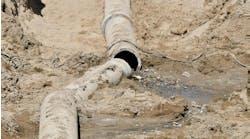BY BILL MORRIS
SPECIAL TO CONTRACTOR
SOME LEADING mechanical contractors are turning to CPVC pipe and fittings to complete projects on time and under budget as prices for copper and other metals reach historic levels. CPVC enables contractors to reduce material and installation costs for water systems, sometimes by more than 30%.
While CPVC has a proven track record, with more than a decade of use in apartments, condominiums, hotels and homes around the country, many building owners and design engineers have historically preferred copper. The reluctance to use CPVC is changing rapidly, however, as contractors prove its advantages in installation quality and speed as well as cost.
DynaTen Corp., a design/build mechanical systems contractor, recently completed a new Ritz-Carlton in Dallas using CPVC for guest suites on eight floors of the hotel plus another 13 floors of condominiums. The piping carries both hot and cold water throughout the complex, as well as the returns in the condo units.
"We're very particular about what we put into condominiums because of liability issues," says Pat Wilburn, DynaTen's jobsite superintendent. "Charlotte Pipe makes FlowGuard Gold CPVC that's plenum-rated [2550 E84] for flame and smoke spread within return air spaces, which was a huge point with us.
"I have absolutely no qualms about using it on any job where we have to regulate pressures."
Since no welding is involved, installing CPVC requires just a saw, primer and ASTM-rated solvent cement, which Wilburn says means faster installation. In addition to lower installed costs, he points to longer-term benefits of CPVC for building owners:
The reluctance to use CPVC is changing rapidly.
- Better heat retention, which means lower water heating costs;
- No condensation, which reduces the risk of drip damage;
- Quieter operation, with silent water flow and no banging from water hammer; and
- No corrosion, pitting or scaling, which results in less maintenance and no loss of water pressure.
Sam White, president of mechanical contractor Walker-White in Columbia, S.C., says a luxury condominium project at Sand Hills Village proved the effectiveness of the CPVC system to his installers. The developer, M.B. Kahn, designed units that combine commercial and residential spaces within a single building.
Since copper was used for the ground-floor businesses, White says there was initial concern about transitioning from the copper pipe to CPVC for the condo units on the two floors above. CPVC was used for installations less than 2 in. and 100 PSI at 180? F and can be connected to either copper or CPVC for large diameter applications using brass-to-CPVC transition fittings with brass threads.
While installation quality was critical for the Walker-White team, it was the savings achieved with CPVC that impressed the developers, admits White, who is also the company's chief estimator.
"The savings on two buildings netted out at $177,000," White says. "That got their attention.
"Hookup and inspection were simple, and we were able to lay more pipe footage in less time with fewer tools and less preparation time for materials. That was a big benefit, because we were on a very aggressive schedule."
While builders and developers may not look past the savings, it's important for contractors to pre-qualify the new materials with design engineers, White says.
"Design engineers fear the shift to CPVC since they can't be on the jobsite all the time to check for quality," he says. "They just assume that copper will work OK, even if it's not installed right. That's one of the myths about copper."
Walker-White has a reputation for both quality and innovation, White says, so qualifying the CPVC system was relatively simple and the developers have now written it into their specs for the entire 300-acre project.
"Innovators don't just stop with one idea," he adds. "We're in consideration for a lot of work because developers and builders know we're always looking for new products that give them value for the money spent."
Value was the prime reason for Tri-State Plumbing's decision to use CPVC pipe and fittings in a 136-unit multifamily residential project, says Mike Carstens, purchasing agent for the Seattle plumbing contractor. With 40 employees, Tri-State specializes in light commercial and multifamily construction.
CPVC is now widely used in the Pacific Northwest for large diameter piping, Carstens says.
"At first we were looking at it for the labor savings, but since the cost of material has skyrocketed we've switched from copper to CPVC," Carstens says. "We have long-term relationships with developers, and they rely on us to recommend the right materials. We're not going to try anything unless we're absolutely convinced it will work."
Bill Morris is vice president/technical services for Charlotte Pipe and Foundry. He has more than 20 years' experience in the plumbing industry. He can be reached at 800/438-6091.

